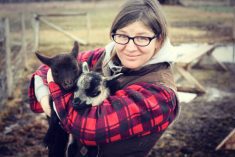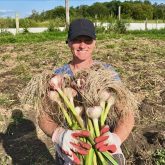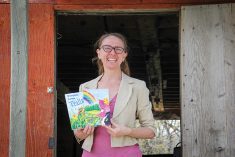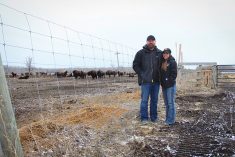Not long ago, Sean Smith was in an Alberta lab learning to identify soil micro-organisms.
He’s not a scientist. He’s a dairy farmer with a penchant for learning and experimentation — an inherited trait at Clanman Jerseys.
“I think that’s probably one of the biggest things about our farm. We’re not afraid to do something different,” Sean told the Co-operator.
Whether it’s the Jersey cows they’ve milked for decades — not switching to Holsteins when many others did — or the water they’re trying to keep on their land instead of draining it, the Minnedosa-area farm is all about finding their own way. This had led them to regenerative agriculture.
The Clanman Jerseys
Though Sean is the third generation to raise Jersey cattle on the family farm, the Smith family has lived on that land for nearly 110 years.

His grandparents, Tom and Sheila, brought cattle onto the farm and started selling cream, likely the reason they chose registered Jersey cows, which Sean said produce less milk but with higher butterfat content. The smaller cattle also eat less.
Sean grew up helping on the farm, often alongside trainees from Australia, England, Japan and France who had come to their farm through an exchange program.
It was trainees from Australia and New Zealand who got his dad, Steven, into intensive grazing — the beginning of their regenerative agriculture journey.
After high school, Sean said agriculture seemed like the right fit.
“All I thought about, all I did, was cows, cows, cows,” he said.
So much so that it was tough to get through his two-year agriculture diploma at the University of Manitoba — especially since what he was learning in his livestock courses seemed elementary. He considered dropping out to farm, but he saw it through.
Read Also

What I learned about Manitoba eggs
Manitoba-laid eggs provide good, locally produced nutrition while supporting local farmers and the Canadian agriculture industry.
Sean spent a year travelling and working on farms in Australia. Then, about eight years ago, he came back to the farm full time. He and his dad share the physical work half and half, but Sean has taken on much of the management of the operation.
Regenerative dreams
“We were doing (regenerative agriculture) before we knew the term ‘regenerative agriculture,’” Sean said.
Since he was quite young, the cows had been on an intensive grazing program. They also bale grazed.
“I think that was just my dad being cheap,” Sean said — they didn’t have to spread manure then, because the cows did it themselves.
In the eight years that Sean has been on farm, they’ve begun perfecting their methods. They’d grown Italian rye for many years, but one year they decided to mix it with barley and clover.
“It worked really well,” Sean said.
They cut it for greenfeed, let it grow back in and grazed it that fall. Next year, they added peas. This year, they’re up to 11 species including multiple varieties of clover, and turnips. Next year, they might add flax and sugar beets.
They graze their dairy cows, a practice Sean said has widely fallen out of favour. Their cattle like it, and their health reflects that. It’s also a cheap way to make milk.
They’re trying to reduce herbicides, which hurt the soil microbiology. Sean has a goal of making his hay stands last eight to 10 years, which he expects to accomplish through intensive grazing — skipping first cut one field at a time and using intensive grazing to pack the organic material back into the soil. They’ve also cut out fertilizer by using liquid manure and compost.
The cattle bed on a compost pack, which they turn frequently. The composting heats up the material, killing off pathogens and reducing chances of disease.
The compost is also an opportunity, Sean said. It makes great fertilizer, but he’s experimenting and trying to figure out how to make an extract of it.
“I look at the compost and I see revenue possibilities,” he said, adding that if he can make a good, proven biological extract of it, it could be an added income stream.
In 2019, the then Little Saskatchewan River Conservation District recognized Clanman Jerseys with a conservation award for its work preserving wetlands.
The award was surprising and humbling, said Sean.
Steven has always worked to preserve nature and make good habitat — both for wildlife and the cattle. Sean didn’t always see the value of this (he would have preferred to shoot the beavers instead of letting them dam up their water) but he’s since come on board.
They began building small dams as a way to reduce erosion. Water would rush across their land to a large, nearby slough damaging pasture and wiping out roads in the process.
The mentality has shifted to keeping water on their land, either through dams or by increasing the water-holding ability of the soil.
After a couple of dry summers, the strategy makes sense to Sean who has seen dugouts dry up and other farmers’ milk production drop after their wells began to dry up.
“We have seasonal creeks. My dream would be to create so much water-holding capacity in our system that those creeks can have water in different spots all year round,” Sean said. “It’s so nice to be able to go down and see families of ducks in your dugouts or your sloughs.”




















